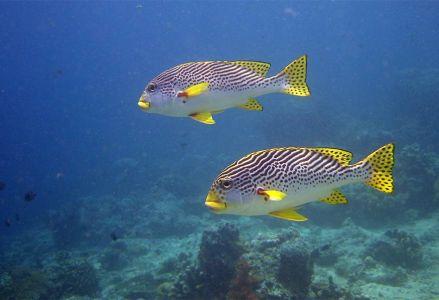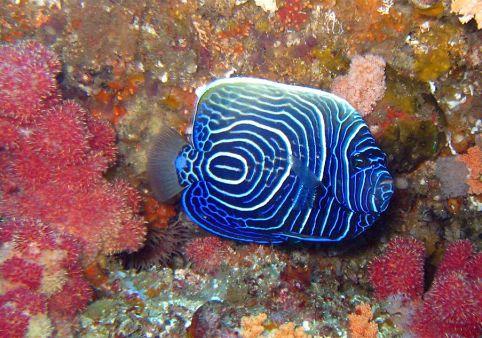 Yellowbanded Sweetlips (Plectorhinchus lineatus) Photo by Henry and TersiaThe East of Eden Similan diving site is almost a thing of myth. It is surely one of the most beautiful diving sites in Thailand, and possibly the world. It does exist, and you can dive there! In the last ten years, East of Eden has been closed to the public more than once. As of the end of the 2012/13 diving season it is officially open to divers. This is excellent news, because there really are few underwater oases more picturesque than this.
Yellowbanded Sweetlips (Plectorhinchus lineatus) Photo by Henry and TersiaThe East of Eden Similan diving site is almost a thing of myth. It is surely one of the most beautiful diving sites in Thailand, and possibly the world. It does exist, and you can dive there! In the last ten years, East of Eden has been closed to the public more than once. As of the end of the 2012/13 diving season it is officially open to divers. This is excellent news, because there really are few underwater oases more picturesque than this.
- Suitable for all divers
- Breathtaking visibility and colours
- Gently-sloping reef covered in dozens of bommies
- Rapidly-recovering corals since 2010
Up to date and accurate reports are difficult to come by or trust, and the 'on-and-off' news about East of Eden has been quite frustrating for many divers who want to visit the Similan Islands on Thailand's west coast. The most recent closure was due to a natural occurrence in April and May 2010, when sea temperatures rose, causing many corals in the area to die off. Later that year the media made quite a big deal about it and, in a typically-Thai knee-jerk way, decided to close several areas to the public. In a much more low-key way, they reopened East of Eden at the beginning of 2013. This is wonderful news, because even without the beautiful colours of healthy corals this is still an outstanding diving location, which is suitable for all levels of diver. It's quite big, easy to dive, has lots of life, and usually has the best visibility of any reef in Thailand.
The location of East of Eden is on the southeast corner of Koh Pabu, which some still call Island 6, but is now Island 7. It runs north-south and can be entered at either end depending on the currents and how many other boats are there already. It is now becoming common knowledge that the site has reopened. The colourful reef comes up from a depth of nearly 40 metres almost to the surface, so snorkelling and night diving are popular here. However, with both the tsunami and the 2010 bleaching, the soft corals and anemones in shallow water suffered the most. These are the fastest to grow back but some damage is still evident. Just over half way down the reef is where most divers at East of Eden spend their time and/or end up. Here they will come across the largest bommie in the archipelago. It is covered in hard and soft corals, anemones and sea fans. Its top is at a depth of around 8 metres and it sits on the sandy bottom at about 25 metres. Some love it so much that they can spend most of their dive on this bommie alone. It is teeming with invertebrates and fish of all shapes and sizes. It even gets visits by passing turtles and sea snakes. The rest of the dive site is similar, with bommies on sand scattered around among sea fans and areas of hard corals, such as table coral and sheet coral. The soft corals are usually blue and purple, but come in several other colours, too.
 Blue Ring Angelfish (Pomacanthus annularis) Photo by Henry and TersiaIt's very difficult to know which fish and invertebrates not to list here, such is the range of different life forms. The usual suspects of Similan marine fish and sharks and rays are all present, including various species of Snapper (Lutjanus), many of which decide to hide in dark and sheltered areas under outcropping corals on and around the bommies. A couple of interesting fish here are a pair of Yellow Longnose Butterflyfish (Forcipiger flavissimus) and a shy Regal Angelfish (Pygoplites diocanthus), which is usually found hiding at the big bommie at about 16 metres. For many years there was a large specimen of Giant Moray Eel (Gymnothorax javanicus) in the main bommie. It was known by many names, and has sadly died. However, another eel of the same species but a little smaller has taken the place and appears to enjoy being visited and photographed. Other notable fishes to see are solo Triggerfish (Balistoides), usually the Titan and Indian species, and huge schools of Fusilier (Caesionidae) and Glassfish. Slow-moving and usually solo Lionfish (Pterois) lumber around without a care in the world and Potato Grouper (Epinephelus tukala) do similarly. Finally, the very eagle-eyed or lucky diver can spot Ornate Ghost Pipefish (Solenostomus paradoxus) and Frogfish (Antennariidae) if they have the patience.
Blue Ring Angelfish (Pomacanthus annularis) Photo by Henry and TersiaIt's very difficult to know which fish and invertebrates not to list here, such is the range of different life forms. The usual suspects of Similan marine fish and sharks and rays are all present, including various species of Snapper (Lutjanus), many of which decide to hide in dark and sheltered areas under outcropping corals on and around the bommies. A couple of interesting fish here are a pair of Yellow Longnose Butterflyfish (Forcipiger flavissimus) and a shy Regal Angelfish (Pygoplites diocanthus), which is usually found hiding at the big bommie at about 16 metres. For many years there was a large specimen of Giant Moray Eel (Gymnothorax javanicus) in the main bommie. It was known by many names, and has sadly died. However, another eel of the same species but a little smaller has taken the place and appears to enjoy being visited and photographed. Other notable fishes to see are solo Triggerfish (Balistoides), usually the Titan and Indian species, and huge schools of Fusilier (Caesionidae) and Glassfish. Slow-moving and usually solo Lionfish (Pterois) lumber around without a care in the world and Potato Grouper (Epinephelus tukala) do similarly. Finally, the very eagle-eyed or lucky diver can spot Ornate Ghost Pipefish (Solenostomus paradoxus) and Frogfish (Antennariidae) if they have the patience.
Diving East of Eden is possible once more and there are more and more boats going out to revisit this underwater paradise every month. The diving season starts again in late October, so now is the time to book a speedboat day trip or liveaboard cruise to dive at East of Eden and other Similan Islands diving sites. We offer places on every boat that goes out there at the best prices. Just click below to find the package which best suits your schedule, budget and any special requirements.



